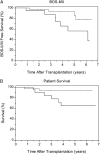Reflux-induced collagen type v sensitization: potential mediator of bronchiolitis obliterans syndrome
- PMID: 20418369
- PMCID: PMC2913763
- DOI: 10.1378/chest.09-2610
Reflux-induced collagen type v sensitization: potential mediator of bronchiolitis obliterans syndrome
Abstract
Background: Lung transplantation continues to have poor long-term survival partly because of the high incidence of bronchiolitis obliterans syndrome (BOS). Gastroesophageal reflux disease (GERD) has been implicated in BOS pathogenesis. We investigated the role of collagen type V [col(V)] sensitization in this process.
Methods: Only primary lung transplant recipients were included. Reflux status was assessed with pH monitoring, impedance plethysmography, and esophagogastroduodenoscopy. Sensitivity to col(V) was determined with trans vivo delayed-type hypersensitivity reaction (DTH). Kaplan-Meier analyses were performed.
Results: Of the 54 recipients, 26 had proven GERD. There were no significant between-group differences in diagnosis; donor and recipient age; sex; ischemic time; single vs bilateral; human leukocyte antigen A, B, and DR matching cytomegalovirus status; acute rejections; or mean follow-up period. The mean DTH response in the GERD group was 25.7 x 10(-4) inches vs 18.3 x 10(-4) inches in the non-GERD group (P = .023). There was a significant reduction in BOS-free survival in the GERD group for both BOS-I (GERD+, 28.3%; GERD-, 86.6%; P = .0001) and BOS-II/III (GERD+, 66.2%; GERD-, 91.7%; P = .0374). A second cohort of 53 patients awaiting lung transplantation also was assayed. The mean DTH response in the GERD group was 24.0 x 10(-4) inches vs 13.1 x 10(-4) inches in the non-GERD group (P = .003). There were no differences in age or sex.
Conclusions: GERD is strongly associated with the development of BOS after primary lung transplantation. Col(V) sensitization is associated with reflux and BOS and may play an intermediary role in the pathogenesis of BOS. Trials using col(V) reactivity to assess the impact of antireflux procedures in patients with lung transplantation and idiopathic pulmonary fibrosis are warranted.
Figures



References
-
- Tilney NL, Whitley WD, Diamond JR, Kupiec-Weglinski JW, Adams DH. Chronic rejection—an undefined conundrum. Transplantation. 1991;52(3):389–398. - PubMed
-
- Burke CM, Theodore J, Dawkins KD, et al. Post-transplant obliterative bronchiolitis and other late lung sequelae in human heart-lung transplantation. Chest. 1984;86(6):824–829. - PubMed
-
- Nicod LP. Mechanisms of airway obliteration after lung transplantation. Proc Am Thorac Soc. 2006;3(5):444–449. - PubMed
-
- Glanville AR, Aboyoun CL, Havryk A, Plit M, Rainer S, Malouf MA. Severity of lymphocytic bronchiolitis predicts long-term outcome after lung transplantation. Am J Respir Crit Care Med. 2008;177(9):1033–1040. - PubMed
-
- Kuo E, Bharat A, Goers T, et al. Respiratory viral infection in obliterative airway disease after orthotopic tracheal transplantation. Ann Thorac Surg. 2006;82(3):1043–1050. - PubMed
MeSH terms
Substances
Grants and funding
LinkOut - more resources
Full Text Sources
Medical
Research Materials

